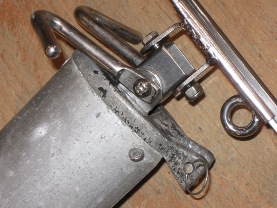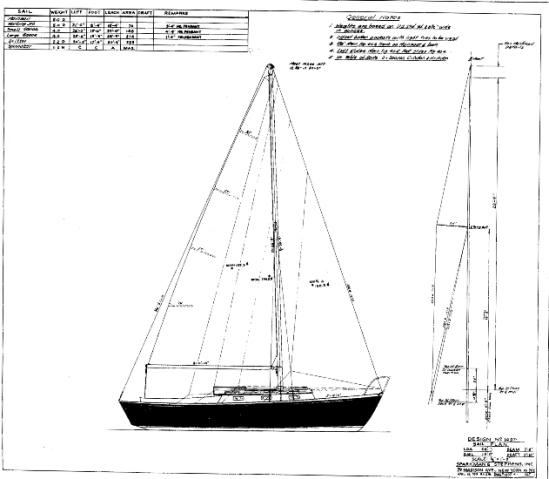A lot of water has flowed under the bridge in sail design since but here are the sail plan numbers lifted from the April 15, 1959 drawing:

The full drawing appears below. A good understanding of the dimensions and measurements is necessary. PHRF certificates are a good start.
Click here to go to the (Eastern Connecticut Sailing Association (ECSA) PHRF regulations and dimension definitions.
Click here to go the the actual (ECSA) PHRF Measurement Certificate for Marionette
Thanks to Mahew/Matt Bemis (Shambles, Yankee #203), who responded to a request on the Forum, some key dimensions are summarized with comments - below the sail plan.
Webmaster Note: March 31, 2009. Sails have come a long way in 50 years. There are a lot of variables that your sailmaker will help provide imput to your main sail design decisions - things like flat or full cut, high roach, batten length, multiple reef points, flattening reef, loose footed, cunningham cringles, outhaul systems, cloth weight, etc. Dolphins are wicked fast in light air so a big, high roach main is high octane. They are also 'tender' so having a good traveller and quick reefing is important.
 Marionette has a high roach main and longish battens that keep that roach out there. It has 2 sets of reef points and a good cunninghan and outhaul system. There are reef hooks on either side of the gooseneck fitting, and a hook type cunningham that is easy to re-attach to a reefed main. We are not bashful about reefing early. Marionette has a high roach main and longish battens that keep that roach out there. It has 2 sets of reef points and a good cunninghan and outhaul system. There are reef hooks on either side of the gooseneck fitting, and a hook type cunningham that is easy to re-attach to a reefed main. We are not bashful about reefing early.
Jibs are a whole other matter and depend a lot on local sailing conditions. Marionette, which sails a lot on Long Island Sound where summer winds can be light, has hanked on jibs (no roller furling). She carries a light 170% as her #1 - good to 10 knots max, and that only costs 3 sec/mile in PHRf rating; a 'heavy' #2 that is 140%, good to 15+ kts - and that I wish was reefable; and a 'heavy' blade sail that is 7/8ths on the forestay and trims inside the shrouds.
We have a max'ed out 1/2 oz polyester running spinnaker which, with the high roach main, focuses on close to dead down wind sail power up to 10/12 knots apparant wind max. We have a couple of old spinnakers we could use in stronger breeze, but we don't - this is a 50 yr old boat! Reaching is not a Dolphin strength, in my opinion, so we don't have a 'new' reaching spinnaker. We use a small, good condition, Atlantic Class spinnaker when necessary.
The specs on the running spinnaker - max girth - 16.17' (higher shoulders); luff 30.27'
Click on the image below and you will see a much larger image on the sail plan with the major basic rig dimensions you need for the various sails, as S&S specified them in 1959.

Click on the image
***********************
Here are Matt's clarifying comments on the sail plan numbers
Hi Nate,
I find the numbers in the picture tough to read so here goes...
Rig dimensions are as follows for the Yankee Dolphin:
I 30.8
J 9.0
P 26.8
E 11.8
"P" is the luff length of the mainsail, measured along the aft face of the mast from the top of the boom to the highest point that the mainsail can be hoisted or black band.
"E" is the foot length of the mainsail, measured along the boom from the aft face of the mast to the outermost point on the boom to which the main can be pulled or to the black band.
"I" is measured along the front of mast from the genoa halyard to the main deck. The main deck is where the deck would be if there were no deckhouse.
"J" is the base of the foretriangle measured along the deck from the headstay pin to the front of the mast.
You certainly want to verify these numbers on your boat, but they should be pretty standard. Keep in mind that these measurements are in feet only, not feet and inches (standard for most sailmakers). Example....11.8 feet is about 11 feet 10 inces.
I found these to be quite accurate on my boat. I also got these numbers e-mailed to me from S&S before this wonderful site was up and running. They were quite helpful.
Edited by Mahew
18 Mar 2008 at 9:21pm
Yankee Dolphin Hull # 203
*********************
July 18, 2011. We had an interesting question on the Forum about the the clearance required for a dodger. This is related to the so called black band on the mast in the neighborhood of the gooseneck. This band determines the maximum low location on the slide track of the top of the boom for handicap measurement purposes. This is not an issue for those that do not race but is for those who do.
On the Sail Plan drawing above there is a side view and measurements of the mast that locate the top of the boom in its lower position. I read it as 24" above the top of the trunk at the centerline. I think this is where the 'black band' is supposed to be. Then the clearance you need for the top of a dodger is based on the section dimensions of your particular boom.
|
